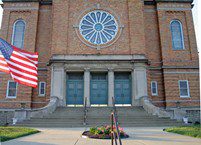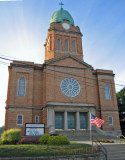“The mystery celebrated in the liturgy is one, but the forms of its celebration are diverse.” CCC 1200
The various Rites of the Church
In the celebration of the Mass, the Catholic Church recognizes a variety of different “rites” or ways of celebrating the liturgy. A Catholic may fulfill their obligation by attending any of the rites of the Church that are in union with the Pope.
The Glossary of the Catechism explains what we mean by “rites”:
“The diverse liturgical traditions in which the one catholic and apostolic faith has come to be expressed and celebrated in various cultures and lands; for example, in the West, the Roman and Ambrosian (Latin) rites; in the East, the Byzantine, Coptic (Alexandrian), Syriac, Armenian, Maronite, and Chaldean rites (see CCC 1201–1203).”
“Holy Mother Church holds all lawfully recognized rites to be of equal right and dignity, and that she wishes to preserve them in the future and to foster them in every way.” (CCC 1203)
The Roman Rite
Most Catholics in America are accustomed to the Roman Rite in what is called the “ordinary form.” But the Roman Rite may also be celebrated in its “extraordinary form” according to the 1962 missal. This is often called the “Latin Mass,” even though this is not the most precise title, as you could also celebrate the current day “ordinary form” of the Mass in Latin as well.
There are 3 different forms of celebrating the Roman Rite:
1) The Ordinary Form of the Roman Rite
This is what most American Catholics are used to. Normally celebrated in the language of the country (the “vernacular”), this Mass may also be celebrated in Latin.
2) The Extraordinary Form of the Roman Rite (often called the “Latin Mass”)
Mass celebrated almost entirely in Latin, according to the 1962 missal (the readings and homily are in the vernacular). The priest stands on the same side of the altar as the people, facing the altar as he leads the people in prayer. The Mass and other sacraments are celebrated in Latin according to the Roman Ritual in force at the time of the Second Vatican Council. Some institutes have permission to celebrate the Extraordinary Form routinely, such as the Priestly Fraternity of St. Peter and the Institute of Christ the King Sovereign Priest. However, any Latin Rite priest may now offer the Mass and other sacraments in accordance with norms of Summorum Pontificum.
In this document, Pope Benedict XVI explained that there is “no contradiction” between the current edition of the Roman Missal and the 1962 edition. Rather, he views these two different forms of the Roman Rite as “mutually enriching.” In his letter to the Bishops of the world, on the publishing of Summorum Pontificum, he wrote:
“The Roman Missal promulgated by Paul VI is the ordinary expression of the ‘Lex orandi’ (Law of prayer) of the Catholic Church of the Latin rite. Nonetheless, the Roman Missal promulgated by St. Pius V and reissued by Bl. John XXIII is to be considered as an extraordinary expression of that same ‘Lex orandi,’ and must be given due honour for its venerable and ancient usage. These two expressions of the Church’s Lex orandi will in no any way lead to a division in the Church’s ‘Lex credendi’ (Law of belief). They are, in fact two usages of the one Roman rite.”
3) The Anglican use form
Since the 1980s the Holy See has granted some former Anglican and Episcopal clergy, who have converted, with their parishes, permission to celebrate the sacramental rites according to Anglican forms, which have been doctrinally corrected.
For more information, see EWTN’s Explanation of Catholic Rites
Frequently asked Questions about the Extraordinary Form of the Mass

